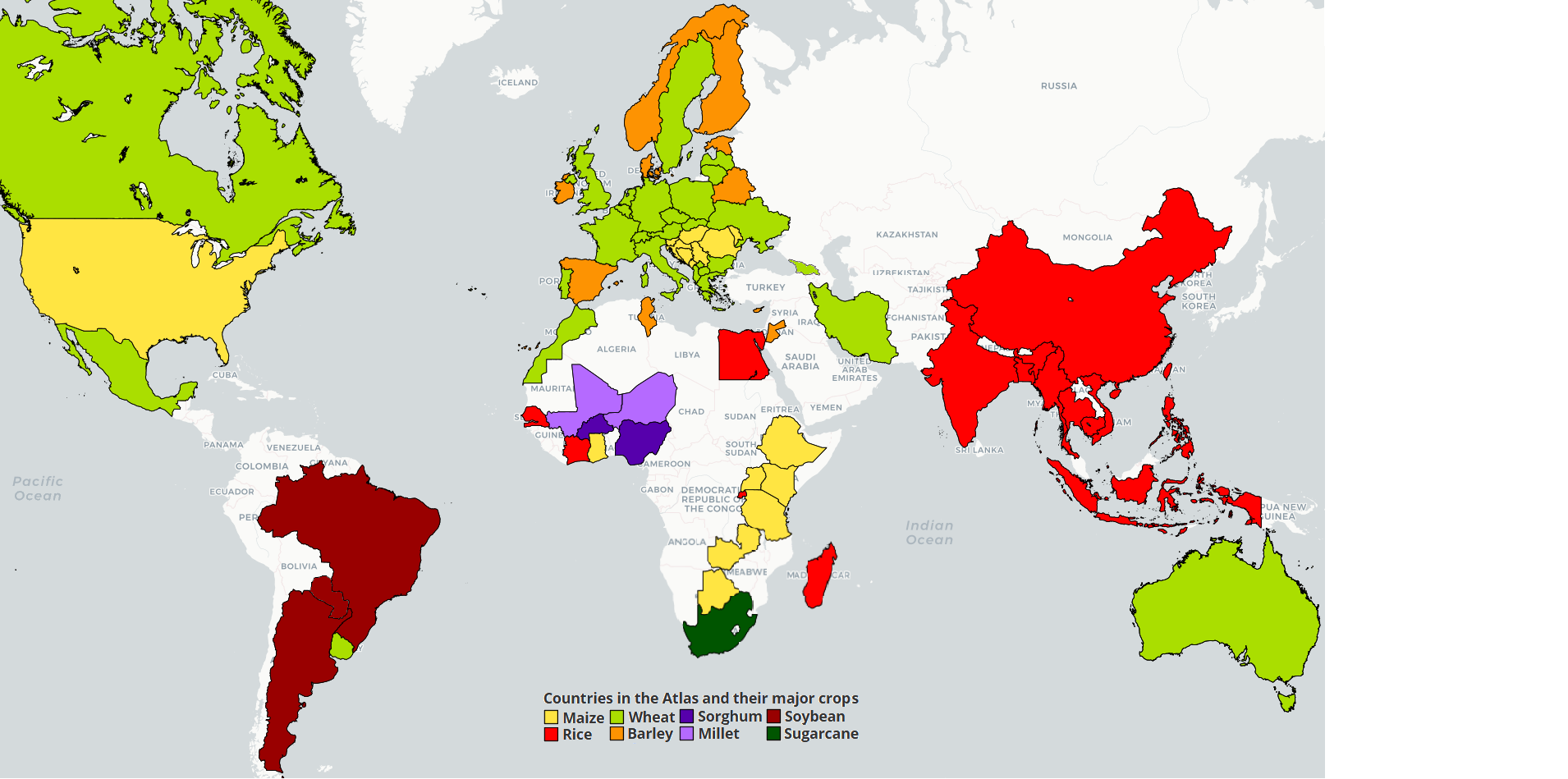Canada
Description of wheat cropping systems, climate, and soils
Major field crops grown in Canada are wheat, canola, mustard, barley, ryes, oat, maize, soybean, and pulse crops, which account for 90% of the total agricultural crop area. The wheat area in Canada occupies about 9.5 million ha, a figure that has been stable for the past 20 years (FAOSTAT, 2022; Statistics Canada). The most important wheat producing area is the Canadian Prairies, which is located mainly across the provinces of Alberta, Saskatchewan, and Manitoba, accounting for more than 90% of national production of this crop (Newlands et al., 2014). Average rainfall accumulation ranges from 300 to 550 mm annually, most of which occurs during spring and summer (McGinn, 2010). Only ca. 5% of the total wheat area is irrigated. Soils are generally deep (160-200 cm), fertile, and rich in organic matter. Dominant soils correspond to Chernozemic and Luvisolic orders (Soils of the Prairie Provinces – Digging into Canadian Soils; www.usask.ca).
We focused here exclusively on spring wheat and, specifically, the Canada Western Red Spring (CWRS) market class, as this is the most widely grown wheat class across the Prairies and is a premium export commodity among wheat types (Table 1). Spring wheat is typically sown from mid-to-late April through May, after a winter fallow, and reaches maturity during July-August. This crop is usually grown under conservational tillage, in rotation with field pea, canola, or other cereals such as barley (Gill, 2018).
Table 1. Wheat production, harvested area, and average yield in Canada (2016-2020). Source: STATCAN.
| Crop | Total Production (Million t) | Harvested Area (Million ha) | Average Yield (t ha-1) |
| Wheat total | 32.5 | 9.5 | 3.4 |
| Spring | 23.8 | 6.8 | 3.5 |
| Winter | 2.6 | 0.5 | 5.0 |
| Durum | 6.0 | 2.2 | 2.7 |
Data sources and assumptions
Harvest area and actual yields
The SPAM harvested area maps (around year 2010) were used for selecting the reference weather stations for each crop and water regime case (i.e. irrigated and rainfed). Local-level data on crop harvested area and average yields (2014-2018) were retrieved from the ‘crop risk areas’ database (https://afsc.ca).
Weather data and reference weather stations
Based on crop harvested area distribution and the agro-climatic zones defined for Canada (Van Wart et al., 2013), a total of 6 and 26 reference weather stations (RWS) buffers were selected for irrigated and rainfed wheat, respectively, following van Bussel et al (2015). Selected buffers accounted for 52% and 61% of total harvested area for irrigated and rainfed wheat, respectively. The agro-climatic zones where these locations were located accounted for 73 and 90%, respectively, of the national area for these crop-water regimes combinations. Long-term, measured daily weather data (from the last 16 years), including maximum and minimum air temperature and precipitation, were obtained from the Environment Canada and Climate Change website (https://climatedata.ca/download/). Solar radiation was retrieved from NASA Prediction of Worldwide Energy Resource (POWER; http://power.larc.nasa.gov/). Quality control and filling/correction of the weather data was performed based on GYGA weather protocols. Rainfall was corrected using NASA-POWER for some years in six weather stations: Lacombe (2009), Weyburn (2013-2018), Lethbridge (2014), Del Bonita (2014), Champion (2014), and Rosetown (2003-2018).
Soil data
For rainfed crops, the dominant soil series were identified for each RWS buffer based on the ‘Gridded Soil Landscapes of Canada’ (Open Government Portal). Proportion of each soil within the wheat growing area in each buffer, and associated soil texture and depth, were retrieved (http://sis.agr.gc.ca/cansis/nsdb/slc/v3.2/index.html). Other variables needed for crop simulations, such as plant available water holding capacity (PAWHC) and bulk density, were estimated from the reported soil properties and generic relationships reported in the literature (Soltani, 2012; Saxton and Rawls, 2006). Finally, wheat harvested area within each soil type within each RWS buffer was calculated and we included as many soil types as needed to cover ≥50% wheat area within each buffer.
Crop system and management information for crop simulations
Management practices were obtained for each RWS buffer. Sowing date window, plant population density, dominant cultivar, and water regime were retrieved from wheat commissions, extension bulletins, variety performance trials, and local/provincial agronomists. The provided data were subsequently corroborated by other national experts.
Simulations of widespread spring wheat varieties for each region were performed using the CERES-wheat model embedded in DSSAT v 4.6.1.0 (Jones et al., 2003). Genetic coefficients were derived and validated for this analysis based on data from 59 well-managed experiments across the Canadian Prairies (Beres et al., 2013; Mangin, unpublished). Following this approach, crop phenology and yield were calibrated based on three spring wheat cultivars: Superb, Viewfield, and Brandon.
Simulations were based on weather, soil, and management data obtained for each RWS. For each RWS, all selected soil types were simulated and then weighted by their relative share of wheat harvested area to retrieve an average Yw at the level of the RWS buffer. To account for differences in soil water content at sowing among years, rainfed wheat crops were simulated in series (2003-2018), which means that each crop was simulated sequentially to account for i) water left in the soil profile at maturity of the prior crop and ii) rainfall occurring during the fallow period before sowing. Simulations assumed no limitations to crop growth by nutrients and no yield reductions due to weeds, pests, and diseases.
A weighted average actual yield was calculated based on the actual yield reported, separately for rainfed and irrigated crops, for the ‘risk zones’ that coincided with the buffers and the relative contribution to the total crop harvested area in the buffer zone. Yield gap (Yg) was calculated as the difference between long-term average Yw or Yp (2003-2018) and average actual farmers' yields (2014-2018). Including more years before 2014 in the calculation of average actual yield would bias the estimate of average actual yield due to a strong, positive technology trend in Canada.
Acknowledges
We thank Don Flaten and Amy Mangin (University of Manitoba) for providing yield and phenological data used for model validation. We also acknowledge the help of Sheri Strydhorst (Alberta Wheat Commission), Bill May (AAFC-Indian Head, SK), Anne Kirk (Manitoba Crop Alliance), John Heard (Man. AG), and Rejean Picard (Man. AG) on providing advice and data corroboration.
References
Beres, B., Pozniak, C., Eudes, F., Graf, R., Randhawa, H., Salmon, D., McLeod, G., Dion, Y., Irvine, B., Voldeng, H., Martin, R., Pageau, D., Comeau, A., DePauw, R., Phelps, S., Spaner, D., 2013. A Canadian ethanol feedstock study to benchmark the relative performance of triticale - Part I: Agronomics. Agronomy Journal 105: 1695-1706.
Gill, K.S., 2018. Crop rotations compared with continuous canola and wheat for crop production and fertilizer use over 6 yr. Canadian journal of plant science, 98, 1139-1149.
Jones, J.W., G. Hoogenboom, C.H. Porter, K.J. Boote, W.D. Batchelor, L.A. Hunt, P.W. Wilkens, U. Singh, A.J. Gijsman, and J.T. Ritchie. 2003. DSSAT Cropping System Model. European Journal of Agronomy 18:235‐265.
McGinn, Sean M., 2010. Weather and climate patterns in Canada’s prairie grasslands. Arthropods of Canadian grasslands 1, 105-119.
Newlands, N.K., Zamar, D.S., Kouadio, L.A., Zhang, Y., Chipanshi, A., Potgieter, A., Toure, S., Hill, H.S., 2014. An integrated, probabilistic model for improved seasonal forecasting of agricultural crop yield under environmental uncertainty. Frontiers in Environmental Science, 2, 17.
Saxton, K. E., and W. J. Rawls. 2006. "Soil water characteristic estimates by texture and organic matter for hydrologic solutions." Saxton, Keith E and Rawls, Walter J 1569-1578.
Soltani, A. 2012. Modeling physiology of crop development, growth and yield. CABi.
Soltani, A., V. Maddah, and T. R. Sinclair. 2013. "SSM-wheat: a simulation model for wheat development, growth and yield." Int. J. Plant Prod 711-740.
van Bussel, L.G., Grassini, P., Van Wart, J., Wolf, J., Claessens, L., Yang, H., Boogaard, H., de Groot, H., Saito, K., Cassman, K.G. and van Ittersum, M.K., 2015. From field to atlas: upscaling of location-specific yield gap estimates. Field Crops Research, 177, 98-108.
Van Wart, J., Van Bussel, L.G.J., Wolf, J., Licker, R., Grassini, P., Nelson, A., Boogaard, H., Gerber, J., Mueller, N.D., Claessens, L., Cassman, K.G., Van Ittersum, M.K., 2013. Reviewing the use of agro-climatic zones to upscale simulated crop yield potential. Field Crops Res. 143, 44-55.
Get access to the Atlas for advanced users
Download GYGA results
 | Please read the license information in case you are interested in using the data from the Global Yield Gap Atlas. |
| read more>> |
 Country agronomists
Country agronomists
|
Brian Beres Agriculture and Agri-Food Canada, Lethbridge Research and Development Centre |
|
Maya Subedi Agriculture and Agri-Food Canada, Lethbridge Research and Development Centre |



